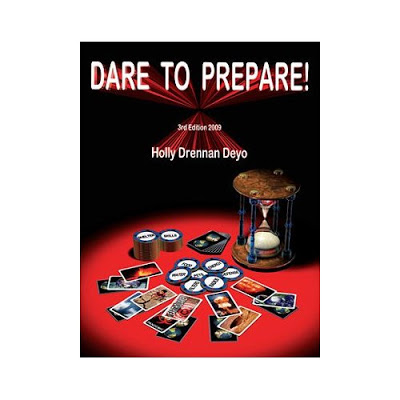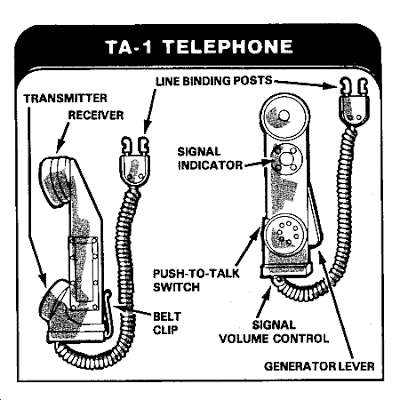
The other day I received in my post office box, courtesy of Irregular Stan, a copy of Holly Drennan Deyo's massive Dare to Prepare!, a 632 page bible of practical preparation information for any disaster up-to-and-including The End of the World As We Know It. With copious illustrations, this work covers everything from the mundane of water treatment and food storage to preparing for pandemics, earthquakes, even meteor strikes. I have seen a lot of prepper manuals in my time, but I understand why Stan was so enthusiastic to send me a copy. Whatever other "survival manuals" you have on your bookshelf, this one will had something to your knowledge base of whatever subject you're interested in.
My short and sweet review: buy this book and read it now while you can still make best use of the voluminous information within. That said, I have a couple of criticisms of Mrs. Deyo's work that spring from my own thoughts on the subject of surviving societal dislocation resulting from disasters natural or man-made. Some are minor, others not so. Understand, though, that I offer them with the best of helpful intentions, perhaps with a view to the 5th Edition.
Let me preface my suggestions by stating flat out that I have not, in any sense, "read" this work in its entirety. I have deeply skimmed it (is that an oxymoron?) and used the comprehensive index to look for subjects that I have some knowledge of. As I say, I am impressed by the amount of knowledge within and the logic of the book's organization. Mrs. Deyo has reason to be proud of this book and I hope she sells a million of them. But here, as the result of my "deep skimming," are some problem areas that I recognize:

TA-1 sound-powered field telephone.
Under "Communications" (Chapter 33), there is (to me) a glaring omission of battery and sound-powered military field telephony, or the construction of improvised civilian equivalent telephones (such as those used by caver rescue organizations). For over a century during the long years beginning with the invention of the telephone and through the 1980s, the militaries of every country used field telephones to communicate most of their orders and reports, even after the invention of radio, especially in static defensive operations -- and what is survival in place but a static defensive operation? Wire communication is inherently more secure than wireless. Over the years my friends and I have collected dozens of TA-1, TA-43 and TA-312 field telephones, SB-993 and SB-22 manual switchboards and miles of field telephone wire and the reels and reel equipment used to deploy and recover it -- enough to wire a small town's defenses if necessary.
I have written on this subject before, but I would also be interested in a discussion, if current experienced telephone linemen can be found to brain storm the subject, of how the existing wire networks of land-line telephones could be used in an emergency with military or improvised civilian handsets and switchboards to overcome the communication difficulties imposed by an EMP event -- if that is possible at all.
Chapter 39, "Firearms," (pages 408-411) is far too short (a bare 4 pages out of 632, with one of those devoted entirely to the POLITICS of gun control!), incomplete and ill thought through. Mrs. Deyo, who admirably and honestly admits her lack of knowledge of the subject, relies on the input of three experts: Richard, "a knowledgeable friend in law enforcement"; Erik, "a professional law enforcement and full-time firearms instructor (and) 16-year veteran of active and reserve military"; and Ian, "a law enforcement officer in Western Australia with a total of 30 years credit (including) 6 years with Australian Special Forces."
First off, I can't help but think that the police backgrounds of these three fellows has both informed and limited their thinking on this subject. The only chapter sub-heading in these three pages is "Primer on Personal Security." The problem is that personal security FLOWS FROM community security and it is impossible to obtain one without the other. The threats in any disaster scenario you care to name in this country dictate that hard truth. No one family, or small group of families, will be able to deal with multitudinous gangs of roving predators that the break-down of law and order will most certainly occasion. Name any disaster in recent memory that hasn't been characterized by looting. Anybody? Anybody? Bueller? And those are situations where, if the cops (as in Katrina) either ran away, joined in the looting or confiscated firearms from the law abiding, at least the INSTITUTIONS of law enforcement were still in place and functioning. Not so in mega-breakdown. Then all rules, and all bets, are off. Doubtless these three policemen, as well intentioned as they are, fully expect THEIR institutions to continue functioning, so they are unable to see the essential thing -- that what community police functions remain in a serious disaster will either involve existing authorities (such as county sheriffs) being significantly augmented by citizen militia formations, or, if they fail, being completely supplanted by them.
So, I would appreciate a discussion of firearms as adjuncts to community safety as well as personal defense. And that, boys and girls, means a discussion of militia organization and community defense operations.
Much of the three page discussion that is in the book covers the usual arguments of caliber and weapon that gunnies get into -- eternally -- without greater result than expediture of hot air. And much of the discussion suffers from a lack of clear thinking on what firearms are used for -- hunting, personal defense and community defense.
For example, Richard says, "If I had to choose one all-around gun to have it would be the .22."
Let's get one thing straight: THERE IS NO "ONE ALL-AROUND" firearm. That's like saying that there is "one all-around tool" for building a house and making someone choose between a hammer and a power saw. Different firearms are used for different purposes. Period. You will need different tools to do different jobs, plus different training, organization, logistics, etc.
However, those concerns aside, I highly recommend this book as a resource.
10 comments:
Holly's book is very useful but not perfect. Several years ago, I bought a case of these and gave them out as Christmas gifts. The security and firearms section is the weakest part of the book. However, the book is so larger that for Holly to add anything to the next edition, she has to remove something else as she has already hit the book binding limits.
Richard
Retired SBC (now AT&T or whatever their name is this month) installer repairman here.
TA-1 & TA-312 communcation is very easy over current copper twisted pair cable. Aerial, or buried, but buried (sometimes) is easier to access.
The hard part is understanding cable color code and binding post methodology so a person can tap the right line. Even multiple sets can be bridged onto the pair and you have your own party line.
Any vacant (you want vacant)serviceable pair will do, all you have to do is figure out if the opposite ends of you talk points are on the same 'leg' of cable, or are on legs that connect through a crossbox.
If not, you have more of a problem than you can solve. That's why they're called central offices.
A few standard telephone tools are really all that's needed. A ohm/megohm meter, a tone generator and a probe to trace pairs. A 'can' wrench to open terminals, and a standard 'buttin' set.
Of course, the easiest way around this is to recruit one of us that's not retired yet onto the team.
The bad thing today is the current trend of 'fiber to the house'. for Uverse service. In newer subdivisions, there is no wire available.
Mike I will gladly volunteer for the "wire coms" discussion as this right up my alley (I've been a phone man for 40 years and built a "magneto ringing" phone set as a teenager and wired it between our summer house and my grandmothers house. I have lot of ideas I'd like to contribute.
Dr.D III
Mike i have taken the liberty of creating a blog specifically to address the wire comms issue:
http://expedientwiredcomms.blogspot.com/
Dr.D III
Because of this book, I have more than a one year supply of food on hand as well as a lot of other goodies. I's sure that the readers of SSI will be able to contribute a lot of info to Mrs Deyo that will make the 5th & 6th edition of D-2-P a more comprehensive training aid.
Shop carefully. Amazon themselves is not selling any of the editions at present. The Amazon marketplace vendors are selling a mix of 3rd and 4th edition.
I agree there is no one all around best fire arm, but there is a best overall for defensive and offensive combat operations round. The 7.62X51/.308, it has better range than a 5.56, and more penetration. It is available most any where, and our military uses it today.
The Dare to Prepare book can be purchased from the author at the web site www.SteveQuayle.com Enter the main site and the Prep tips and Dare to Prepare can be found there. All the prep tips are freebies and I have already printed most of them.
Thanks for the book review. It will make a terrific father's day gift.
Mike I am not impressed with Stan Deyo, his wife however has put out some good info. Anyone who moved to Austraila and then back is suspect of having some kind of problem...This is just my opinion based on his appearances on C2C years ago...
Dale
Post a Comment